Can AI and the Right Data Rewrite the Rules of Airline Performance?
In Collaboration with

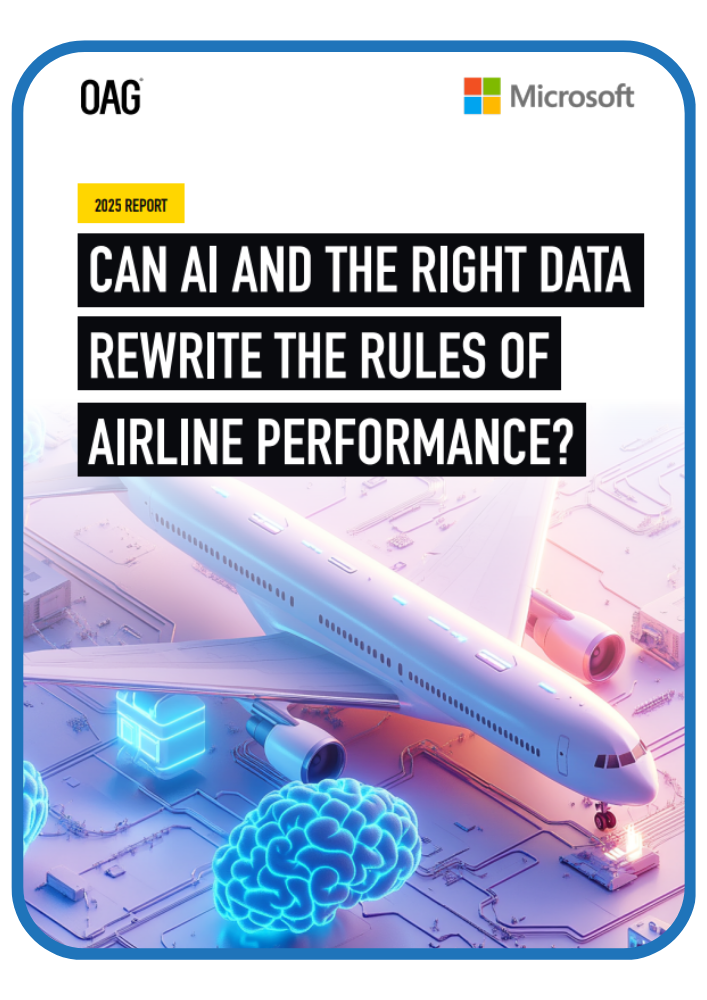
HOW AI TRANSFORMATION AND THE rIGHT DATA ARE BUILDING RESILIENT AIRLINE OPERATIONS
AI is already transforming how airlines and airports manage operations, but its true power lies ahead. This report, in collaboration with Microsoft, maps out the path to resilience through real-world use cases and trusted data.
There is no shortage of discussion about the impact of Artificial Intelligence (AI) on industries worldwide. Aviation is no exception. While AI's potential is frequently debated, many conversations remain abstract, focusing on futuristic scenarios rather than tangible, real-world applications.
This report is different.
Rather than speculating on what AI might mean for aviation in the distant future, we examine how AI is already transforming airline and airport operations today, with a particular focus on solving one of the industry’s most persistent challenges: operational stability, especially around delays and flight irregularities.
Our approach is rooted in applicability. We outline concrete operational bottlenecks that aviation stakeholders face today, analyze their underlying root causes, and highlight real-world AI use cases that are already mitigating these challenges.
From crew scheduling optimization to real-time turnaround management and proactive delay mitigation, AI-powered solutions are not just enhancing airline efficiency; they are fundamentally reshaping the passenger experience from 2025 and beyond.
Here’s what you’ll discover: AI in aviation is no longer a futuristic concept; it is already transforming operations today. The challenge now is how quickly the industry will scale the solutions that define its future resilience.
Introduction: The Industry’s Operational Headache Introduction: The Industry’s Operational Headache
Delays and flight irregularities remain one of the aviation industry’s most persistent and costly operational challenges, impacting airlines, airports, and passengers alike. Despite years of technological advancements and major Airline-Tech innovations in 2024, the industry continues to struggle with operational stability, with delay rates stubbornly high.
Case in point: In 2024, nearly a quarter of all commercial airline arrivals in the U.S. (22%) were delayed by at least 15 minutes, according to OAG’s On-Time Performance (OTP) data. While this may not seem significant at first glance, in an industry where tight operational schedules are planned down to the minute, even small delays have outsized consequences.
Consider this:
- The average scheduled turnaround time for a short-haul, single-aisle aircraft, covering everything from passenger boarding to baggage loading and refueling, is usually just 60 minutes.
- A 15-minute delay instantly erodes a quarter of that critical window, putting immense pressure on ground crews and potentially triggering a domino effect of further delays.
While airlines and airports often point to external factors, mainly weather, as the primary cause, the data tells a more nuanced story. According to the U.S. Department of Transportation Statistics, the majority of flight delays over the past decade have been caused by issues within the control of aviation stakeholders themselves.
- About 30% of all delays were the result of airline and airport operational inefficiencies, such as maintenance issues, crew scheduling conflicts, baggage handling bottlenecks, and aircraft turnaround delays (fueling, cleaning, and taxiing).
- Another 30% of delays stemmed from failures within the national aviation system, including outdated air traffic control (ATC) infrastructure, IT system failures, and staffing shortages.
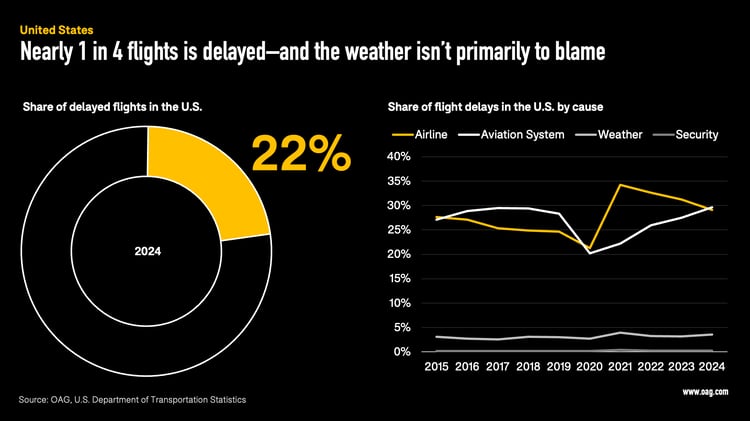
The takeaway? Nearly 60% of all flight delays are industry-related, not acts of nature.
This is not just a U.S. problem. In Europe, delays remain a systemic challenge as well.
- According to Eurocontrol, the average departure delay for flights within Europe is 18 minutes per flight, and less than one minute of this delay can be directly attributed to weather disruptions.
- The vast majority comes from inefficiencies within airline, airport, and ATC operations.
Even worse, delays don’t just impact a single flight. Eurocontrol data highlights a cascading effect, where more than half of the total delay time airlines experience in a given day is caused by previous aircraft running late. A single disruption early in the schedule can trigger a chain reaction of missed connections, displaced crews, and airport congestion – issues that spiral out of control throughout the day.
According to our own OAG On-Time Performance Flight Data, none of the ten busiest airports in Europe achieved arrival punctuality rates above 80% last year, with average OTP across these hubs hovering around 70%. This demonstrates how rare operational mastery truly is, given the complexity and scale of today’s global airline network.
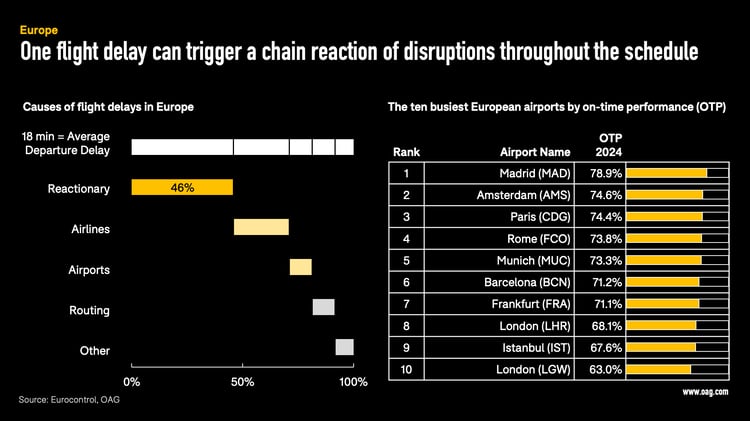
The Cost of Delays
Beyond the operational burden delays impose on airlines and airports, their financial consequences are becoming increasingly severe.
Every minute a flight is delayed adds substantial expenses for airlines, from crew wages and fuel consumption to aircraft usage and maintenance costs.
- Industry estimates from Airlines for America place this cost at approximately $100 USD per minute in 2024.
- When compounded across thousands of daily delays, this quickly escalates into an enormous financial drain worth billions of dollars each year.
Beyond airline expenditures, delays also result in significant economic losses for passengers.
- Business travelers face lost productivity, while leisure travelers experience opportunity costs due to missed connections, disrupted vacations, and other inconveniences.
- According to AirHelp’s estimates, the total economic impact of flight delays in the U.S. alone exceeded $34 billion USD in 2022 when accounting for both airline operational costs and passenger time lost.
There is also a second layer of financial consequences: growing regulatory pressure on airlines. As passenger frustration with flight irregularities grows, regulators on both sides of the Atlantic are intensifying their scrutiny of airline performance, pushing for greater accountability and compensation for disrupted travel.
In the United States, policymakers are actively working to strengthen consumer protection laws, with new regulatory efforts aimed at forcing airlines to compensate passengers for delays and cancellations within their control. Case in point: In early January 2025, the Department of Transportation fined JetBlue $2 million USD for chronic delays (based on just 71% on-time performance across Q1 to Q3 2024) and what it described as “unrealistic scheduling,” marking the first time a U.S. airline has been penalized specifically for operational delays. While the fine itself was largely symbolic, it signals a clear shift: U.S. authorities are no longer willing to accept persistent airline underperformance without consequences.
In contrast, Europe’s regulatory landscape is already far more punitive. Under the EU261 regulation (in place since 2005), airlines are legally required to compensate passengers for delays of more than three hours – a rule that has added a massive financial liability for European carriers over the years.
For context:
- In 2024, nearly 220,000 departing flights across the EU, EEA, and the UK were either delayed by more than three hours or canceled, accounting for 1.5% of all departures.
- The financial impact of these delays is staggering, with affected flights representing over €6.5 billion in potential compensation payouts.
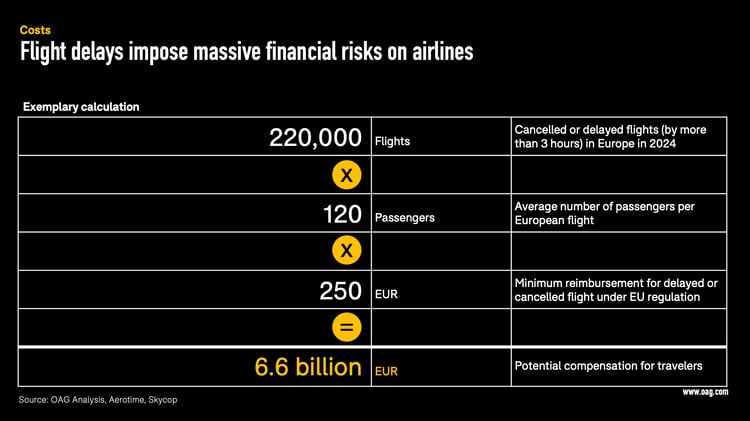
A System That Needs Rapid Improvement
The takeaway from these statistics is clear: aviation depends on highly efficient and resilient operational systems, but the current setup is struggling to keep pace.
With a quarter of flights delayed and global flight volumes reaching record highs, the absence of a meaningful reduction in delays over the past decade highlights a growing imbalance: operational complexity is increasing, yet the tools used to manage it remain largely unchanged. Airlines, airports, and operational handlers can no longer afford to rely on outdated processes to run one of the world’s most complex logistical networks.
The question now is: How does the aviation industry move past this cycle of operational instability?
Large parts of the answer lie in AI, a technology that, if applied effectively, can address deep-rooted inefficiencies and help unlock a more resilient and scalable operational future.
AI as the Game-Changer for Aviation
Artificial Intelligence is no longer a distant, theoretical concept. It is already proving its impact in aviation today.
Two notable B2C examples from Air India show just how rapidly AI capabilities are evolving. While this report focuses primarily on operational applications, these early consumer-facing deployments offer a glimpse into the power of agentic AI systems:
- Air India’s “AI.g” chatbot autonomously handles 97% of all customer queries without human intervention. Built on Microsoft’s AI infrastructure, the system simulates a digital travel agent, using natural voice or text input to guide customers through booking flows in real time.
- A second agentic AI solution by Air India enables “one-click booking,” reducing transaction time by up to 90%. By combining traditional user interface design with AI-driven inputs, the system personalizes travel suggestions and automates the booking journey, even integrating with corporate tools for business travel.
These innovations underscore a broader shift: AI is no longer about isolated features. Instead, it’s about systems that proactively assist, learn, and complete complex tasks across the travel experience.
Applied to airline and airport operations, this same logic unlocks transformative potential across three core dimensions:
- Optimizing decision-making to improve efficiency and reduce delays in real time.
- Enhancing collaboration across all stakeholders, from airlines and airports to ground crews and air traffic management.
- Identifying and resolving systemic vulnerabilities before they escalate into network-wide disruptions.
To show how these benefits translate into real-world impact, this report explores several key themes:
- How AI is redefining aviation operations by addressing inefficiencies at their core.
- The AI-driven use cases that are already making a measurable impact in reducing delays.
- Why data quality and trusted AI models are essential to scaling these solutions successfully.
You will learn why AI is not just an optimization tool. It is the foundation for a new era of operational resilience in aviation.
The Root Causes of Aviation's Operational Struggles The Root Causes of Aviation's Operational Struggles
Before diving into the AI solutions that are transforming aviation, it is essential to understand the underlying drivers behind the industry’s operational vulnerabilities. Airlines and airports do not face these challenges in isolation. Many of the issues disrupting daily operations are deeply structural, requiring long-term strategies to fix.
At the core of aviation’s struggles are three interconnected and worsening shifts, excluding external factors like weather or geopolitical disruptions.
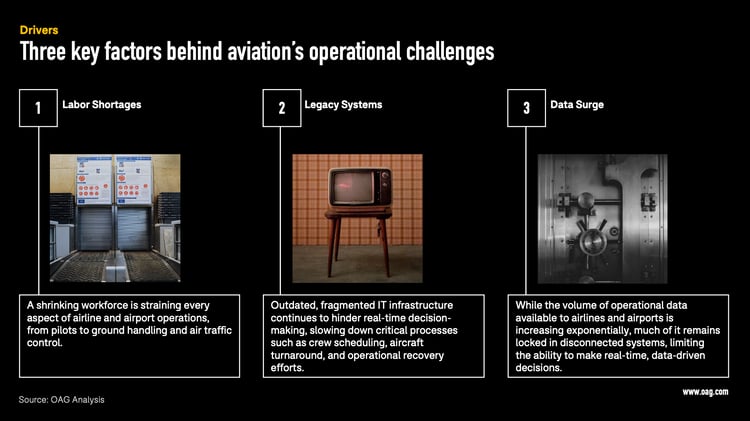
In the following sections, we will take a closer look at how each of these challenges is impacting aviation today and why AI is emerging as the most viable solution to stabilizing, optimizing, and future-proofing operations.
1. Labor Shortages in Times of Aviation Growth
Labor constraints are a growing challenge across many industries, but aviation is disproportionately impacted compared to most other sectors. The reason? A perfect storm of rising flight demand and an inability to hire and retain enough qualified personnel across critical operational roles.
Over the past 25 years, commercial air travel has grown nearly 50% in the U.S. alone (measured by total passengers transported), with global flight volumes following a similar upward trajectory. Yet, while demand has surged, the aviation workforce in the U.S. has remained largely stagnant over the same period. This clearly points to significant gains in labor productivity and process efficiency, but today, airlines and airports are operating beyond the limits of what their existing teams can handle, leaving them short-staffed and operationally strained.
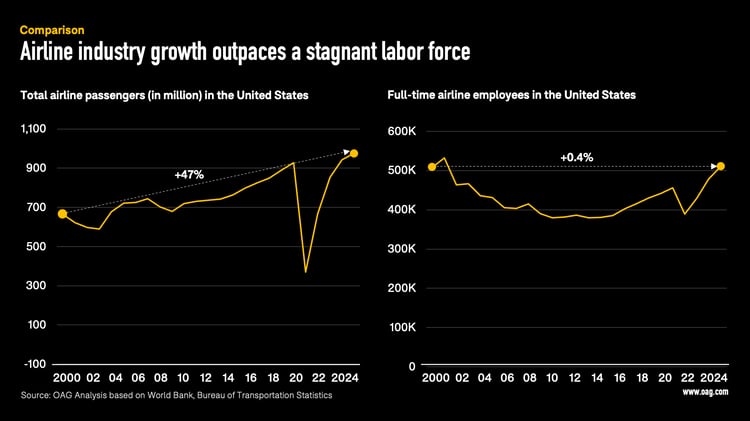
Today, the aviation industry faces a deficit of approximately 32,000 skilled professionals, including pilots, mechanics, and air traffic controllers. This gap is expected to worsen significantly in the coming years, not only due to rising demand but also because a large portion of the existing workforce is nearing retirement. For example, the FAA projects approximately 4,300 pilot retirements annually through 2042.
Several factors have contributed to this widening labor gap, with COVID-19 exacerbating an already fragile system. When travel demand plummeted in 2020, airlines and airports cut routes, furloughed workers, and offered early retirements. As a result, many pilots, flight attendants, mechanics, and ground personnel never returned when demand surged back in 2022 and 2023.
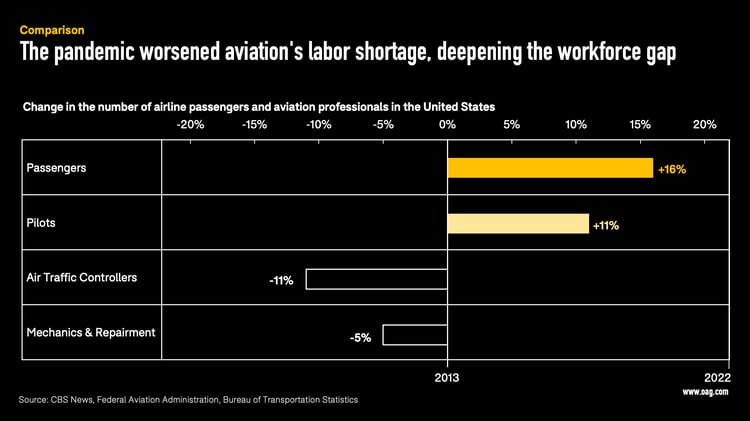
Now, in 2025, airlines and airports continue to struggle to attract and retain skilled aviation professionals, particularly for roles that require years of specialized training:
- Pilots: The global airline industry faces a shortage of tens of thousands of pilots today, with new 2025 estimates projecting a need for up to 674,000 new pilots over the next 20 years.
- Aircraft Mechanics: CBS News reports a deficit of 12,800 trained mechanics in North America alone, projected to worsen to 18,000 in the coming years.
- Air Traffic Controllers: The U.S. has a shortfall of at least 3,000 fully certified air traffic controllers, leading to operational stress and cascading delays.
Despite increased efforts, such as pilot training academies, avionics apprenticeship programs, and financial hiring incentives, the industry cannot simply hire its way out of this crisis. These professions require years of specialized training. Aircraft mechanics, for example, need about two years to enter the workforce. Air traffic controllers require two to five years of rigorous training before certification, often longer in countries with stricter qualification pathways. Germany, for instance, is known for its particularly time-intensive and complex ATC training process, further slowing workforce replenishment.
The takeaway: With airline demand outpacing recruitment, the staffing shortfall is not a temporary crisis – it’s a long-term structural challenge.
The reality is that hiring alone will not solve this crisis fast enough. Instead, technology, particularly AI, is emerging as a critical solution to optimize existing workforce efficiency and reduce dependency on manual labor. How exactly?
AI-powered solutions can help mitigate labor constraints in three major ways:
Assisting Workers:
AI copilots, predictive maintenance tools, and smart scheduling systems enable faster, more efficient decision-making, maximizing the productivity of available staff.
Replacing Routine Tasks:
AI-driven automation and robotics can handle repetitive, time-consuming tasks – such as baggage handling, document processing and flight scheduling – freeing up human workers for more complex responsibilities.
Real-Time Optimization:
AI-powered decision intelligence enables real-time adjustments to crew scheduling, airport operations, and turnaround processes – ensuring smoother operations despite workforce shortages.
By augmenting the capabilities of human workers and automating bottleneck-prone processes, AI presents a viable path forward for an industry that cannot afford to remain stuck in the labor constraints of the past.
2. Disconnected Legacy Systems: The Hidden Bottleneck in Airline Operations
Aviation is an industry built on split-second coordination between multiple stakeholders: airlines, airports, air traffic control (ATC), ground handling, maintenance teams, and regulators. Smooth flight operations, especially given rising travel demand, depend on seamless data sharing, real-time collaboration, and automated workflows. Yet, in reality, the industry still operates with outdated, fragmented infrastructure that often prevents timely communication and decision-making.
The result? Avoidable inefficiencies, miscommunications, and operational bottlenecks that escalate into widespread delays and flight disruptions.
A study by the International Air Transport Association (IATA) found that 63% of airlines struggle with operational silos, and nearly half of all flight delays (47%) stem from poor coordination between functions like ground handling, maintenance, and flight operations.
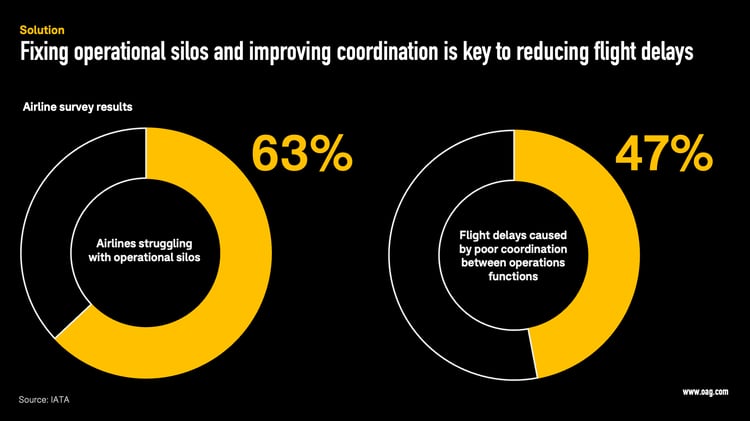
Why are today’s systems struggling? At the heart of this problem is a lack of real-time information flow across key stakeholders.
-
Siloed Communication and Data Flow:
Flight updates, gate changes, aircraft assignments, and turnaround status must be shared instantly, yet many teams still rely on separate dashboards, radio calls, and even manual spreadsheets that fail to integrate across departments.
-
Crew Availability and Scheduling Failures:
Many airlines still use outdated scheduling software that cannot automatically adapt to delays, forcing manual crew reassignments when disruptions occur. Without predictive scheduling models, shortages compound, cascading delays throughout the day.
-
Congested Air Traffic and Slot Coordination:
Poor slot coordination between airlines, ATC, and airports worsens congestion and disrupts efficient scheduling. AI-powered slot optimization models could dramatically reduce manual slot adjustments and increase turnaround efficiency.
-
Maintenance-Related Delays:
A significant share of all flight disruptions stems from unscheduled maintenance issues and inefficient repair workflows. Traditional MRO (Maintenance, Repair, and Overhaul) systems react to failures rather than predict them, causing last-minute operational setbacks.
The bottom line? The aviation industry cannot afford to operate on outdated IT infrastructure. Fragmented legacy systems are no longer just inefficient; they are a liability. Without AI-driven real-time data sharing, automation, and predictive analytics, airlines and airports will struggle to handle future demand efficiently.
3. The Data Surge: Aviation’s Untapped Goldmine
The fragmentation of aviation’s legacy systems doesn’t just hinder collaboration; it also means the industry is struggling to extract value from one of its most powerful and rapidly growing assets: data.
The aviation industry has entered an era of exponential data growth, generating vast volumes of operational insights from flight performance, delays, weather, passenger demand, and pricing trends. But while the data economy has taken hold across multiple industries, airlines and airports still lack the tools to harness this wealth of information effectively.
Nowhere is this data surge more evident than in modern aircraft.
- The Airbus A350, for example, is equipped with 50,000 onboard sensors, producing 2.5 terabytes of data per day of operation.
- Oliver Wyman estimates that by next year, annual aircraft data generation could exceed 100 million terabytes.
- Every flight leaves behind massive virtual contrails of operational, maintenance, and performance data, but much of it remains underutilized.
And it’s not just operational aircraft data.
The aviation sector as a whole is undergoing a seismic shift toward faster and urgent data-driven decision-making, making trusted, high-quality data more mission-critical than ever. At the forefront of this shift is OAG. As the world’s leading aviation data provider, OAG delivers the scale, precision, and real-time intelligence needed to transform raw data into actionable insight. Our data solutions enable accurate, AI-powered decision-making for airlines, airports, and travel-tech providers worldwide, ensuring that as data volumes grow, so does the industry’s ability to act on them.
In summary: High-quality data is the essential starting point. With OAG’s trusted datasets as a foundation, airlines and airports can confidently build advanced analytical models on top that turn complexity into clarity. As Dr. Satya Ramaswamy, Chief Digital and Technology Officer at Air India, explains:
Interpreting these data insights requires rare skills, not easily understood by everyone. You need the help of very powerful technology that can dig into multiple layers of data and then unearth the gems that we can act upon to improve operational performance and customer service. AI helps airlines make sense of the massive amount of data coming our way.
Dr. Satya Ramaswamy, Chief Digital and Technology Officer at Air India

Despite the vast potential of aviation data, many airlines remain stuck in traditional data-processing models, missing opportunities to leverage AI for real-time decision-making, predictive analytics, and process automation.
The Promise of AI in Airline Operations The Promise of AI in Airline Operations
When discussing AI’s role in aviation, traveler-facing applications tend to dominate the conversation. Many airlines have already deployed Generative AI-powered chatbots, virtual assistants, and agentic systems, significantly improving customer interactions by automating responses, resolving common inquiries, and reducing the burden on human agents.
The impact is measurable.
- Several airlines report up to 30% savings in customer support costs thanks to AI-driven automation.
- Other examples go even further: IndiGo’s “6Eskai” chatbot has reportedly cut the workload of its customer service agents by 75%.
But while AI’s role in customer service is well documented, its potential to transform the operational backbone of airlines, such as flight operations, crew scheduling, turnaround management, and disruption handling, is far less publicized. This is despite mounting evidence that AI, especially agentic AI systems, could dramatically enhance aviation efficiency.
Some industry estimates suggest that by leveraging AI across key operational areas, airlines could reduce flight delays by as much as 35% – a game-changing improvement in an industry where time is money.
The key question: What tangible solutions are already in play?
To understand the real impact of AI on aviation’s operational challenges, we need to break its applications down into three key areas:
Optimizing Resource
Allocation:
AI enhances scheduling, staffing, and asset utilization, ensuring that aircraft, crew, and ground operations run at peak efficiency while minimizing downtime and costs.
Enhancing Decision-Making Across Stakeholders:
AI improves coordination between airlines, airports, and air traffic control by making real-time insights available to all key players, breaking down traditional silos.
Predicting and Preventing Disruptions:
AI anticipates delays, congestion, and operational bottlenecks before they escalate, allowing airlines to take proactive measures rather than reacting after the fact.
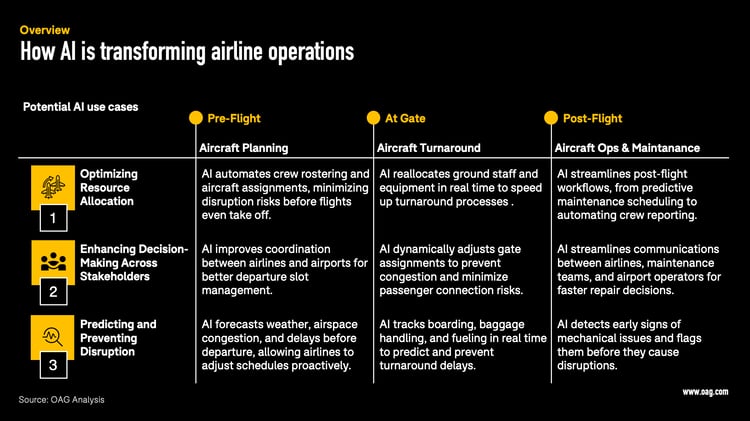
Bridging the Gap Between AI Hype and Real-World Impact
Discussions about AI in aviation often lean toward grand visions of the future: autonomous aircraft, fully automated air traffic control, and predictive systems that eliminate disruptions altogether. While these ideas capture the imagination, they remain highly speculative, with few real-world implementations today.
What’s missing from the conversation is a tangible understanding of how AI is already driving measurable improvements in airline and airport operations today.
Let’s move beyond theory and spotlight concrete AI applications that are already in use by leading aviation players today.
AI in Pre-Flight Decision-Making
Before an aircraft even leaves the gate, airlines must make a series of critical decisions that determine the efficiency of the entire flight operation. From crew scheduling and aircraft assignments to weather forecasting and airspace planning, every factor impacts on-time performance, cost efficiency, and the passenger experience.
This is where AI is making a transformative impact. By harnessing advanced data analytics, predictive modeling, and automation, airlines can optimize pre-flight resource allocation, anticipate potential disruptions, and enhance collaboration between key stakeholders.

Managing an airline’s global operations requires precise coordination of aircraft, crew, and ground resources, a task that generates vast amounts of complex data. Traditionally, interpreting these insights required specialized expertise, leading to delays in decision-making and inefficient resource allocation.
To address this, Air India has integrated AI-powered data analysis into its operational workflow using Microsoft Copilot. The airline’s AI system enables operations teams to quickly analyze flight performance, identify inefficiencies, and make real-time adjustments – all through natural language queries. Instead of relying on siloed reports and manual data interpretation, teams now have instant access to actionable insights on aircraft availability, crew scheduling, and airport constraints.
With this, Air India has significantly improved on-time performance while streamlining cross-department collaboration between operations, ground handling, and maintenance teams. The system also enhances proactive decision-making, allowing the airline to reallocate resources dynamically in response to disruptions, ultimately minimizing downtime and reducing costs.
As one of Europe’s busiest airports, Frankfurt Airport faces the dual challenge of managing growing passenger volumes while addressing an impending workforce shortage. With traffic expected to increase by 30% in the coming years and an aging workforce set to reduce staff availability by the same percentage, operational efficiency has become a critical priority.
To tackle this, Fraport AG, the airport’s operator, has introduced "FraportGPT," an AI-powered digital assistant designed to enhance decision-making across departments. Built on Microsoft’s Azure OpenAI Service, the AI system is integrated into the airport’s existing infrastructure, providing employees across operations, administration, and legal departments with faster access to information, streamlined workflows, and data-driven recommendations.
Rather than imposing predefined AI use cases, Fraport has encouraged employees to explore and adopt AI tools organically, leading to improved cross-department collaboration and faster problem-solving. Airport planners, for example, use AI to analyze flight schedules and optimize resource deployment, while administrative teams leverage it to generate reports, summarize complex regulations, and automate calculations.
FraportGPT is just one of over a dozen AI-driven initiatives currently shaping the future of Frankfurt Airport, supporting its vision of a more automated, efficient, and resilient airport ecosystem.
Weather-related disruptions remain a substantial challenge for airline operations, affecting flight schedules, safety, and efficiency. Traditionally, airlines have mostly relied on government-provided weather data to anticipate risks, but with budget cuts impacting the National Weather Service (NWS) in the U.S., for example, private companies are stepping in to fill the gap.
One of the most advanced players in this space is Tomorrow.io, a company that has built an AI-enhanced weather prediction network using both public meteorological data and its own fleet of weather satellites. Airlines such as United Airlines and JetBlue already use Tomorrow.io’s AI-powered forecasts to predict severe weather conditions in real time, allowing them to adjust flight routes, delay departures preemptively, or reroute aircraft before disruptions escalate.
Unlike traditional forecasting models, which rely primarily on historical weather data, Tomorrow.io’s system collects global atmospheric data every 40 to 60 minutes via its satellite network, continuously refining predictions with the help of AI models. This enables airlines to access highly localized, real-time weather intelligence, improving decision-making around flight operations and mitigating cascading delays caused by unpredictable weather conditions.
AI in Aircraft Turnaround: Reducing Ground Delays and Improving Efficiency
The turnaround process, so the time between an aircraft’s arrival and its next departure, is one of the most critical operational phases for airlines. It involves a highly coordinated sequence of tasks, including passenger deboarding, baggage unloading, refueling, cabin cleaning, catering, and crew changes. Any inefficiency in this process can lead to delays that ripple across an airline’s entire network.
Historically, airlines have relied on fixed turnaround schedules and manual coordination, making it difficult to adjust in real time when delays occur. AI is changing that. By introducing real-time monitoring, predictive analytics, and automated resource allocation, airlines and airports are reducing turnaround delays, optimizing staff deployment, and improving on-time performance.

To streamline one of the most complex phases of flight operations, Eindhoven Airport, in collaboration with Schiphol, has implemented Schiphol’s “Deep Turnaround” solution, an AI-powered system designed to optimize ground handling workflows.
- Using apron-mounted cameras, the system monitors key turnaround tasks in real time, including passenger boarding, baggage loading, and refueling.
- AI models automatically detect the start and end of each task, predict when an aircraft will be ready for departure, and flag potential delays before they escalate.
Crucially, the system shares these insights via a centralized dashboard accessible to all relevant stakeholders: airlines, ground handlers, and air traffic control. This shared visibility enables faster coordination and smarter resource allocation: ground crews can reprioritize tasks dynamically, and air traffic controllers can better manage gate and runway assignments.
The result is a more synchronized, efficient, and predictable turnaround process.
Efficient gate assignments are critical for reducing taxi times, minimizing delays, and ensuring smoother passenger connections. Traditionally, these decisions required a lot of manual coordination, with planners juggling multiple variables such as arrival schedules, runway conditions, and gate availability – a process prone to inefficiencies.
To streamline operations, American Airlines has integrated AI-driven gating technology built on Microsoft Azure.
- This system analyzes real-time flight data, air traffic conditions, and airport logistics to dynamically assign the most optimal gate for arriving aircraft.
- At Dallas/Fort Worth International Airport (DFW), American’s AI-powered gating system has reduced taxi times by over a minute per flight, eliminating up to 10 hours of taxi time daily and saving 870,000 gallons of jet fuel annually. This is a significant cost and sustainability improvement.
Delays on the ground often stem from poor visibility into turnaround progress, especially when airlines are forced to react to delays rather than anticipate them. This is where predictive AI makes a difference.
At Rome Fiumicino Airport (FCO), Assaia’s “ApronAI” solution uses video analytics and machine learning to forecast aircraft readiness well in advance. By generating real-time timestamps for key turnaround activities, such as passenger deboarding, refueling, and catering, the system trains predictive models that estimate departure readiness and pushback times with high accuracy.
This foresight allows ground handlers and airline operators to act earlier and more precisely, preventing last-minute scrambles and ensuring tighter on-time performance.
The results speak for themselves.
- In airports where ApronAI was deployed in 2023 and 2024, overall ground delays dropped by 6%, and turnaround times improved by 4%, despite increased traffic.
- At Rome Fiumicino Airport, the system is now active across 57 gates, with full deployment underway, making it one of the first Skytrax Five-Star Airports to implement AI-driven turnaround monitoring at scale.
AI in Post-Flight Aircraft Operations
The moments after an aircraft touches down are just as critical as those in the air. Post-flight operations, spanning technical inspections, Maintenance, Repair, and Overhaul procedures, and administrative crew tasks, play a decisive role in determining whether the next flight leaves on time. Any delay, inefficiency, or bottleneck at this stage can ripple across an airline’s entire schedule.
Historically, many of these processes have been manual, time-consuming, and siloed across departments and stakeholders. In MRO, especially, the industry has relied heavily on scheduled maintenance rather than predictive diagnostics. Today, AI is beginning to change that by streamlining workflows, accelerating reporting, and enabling smarter coordination on the ground.
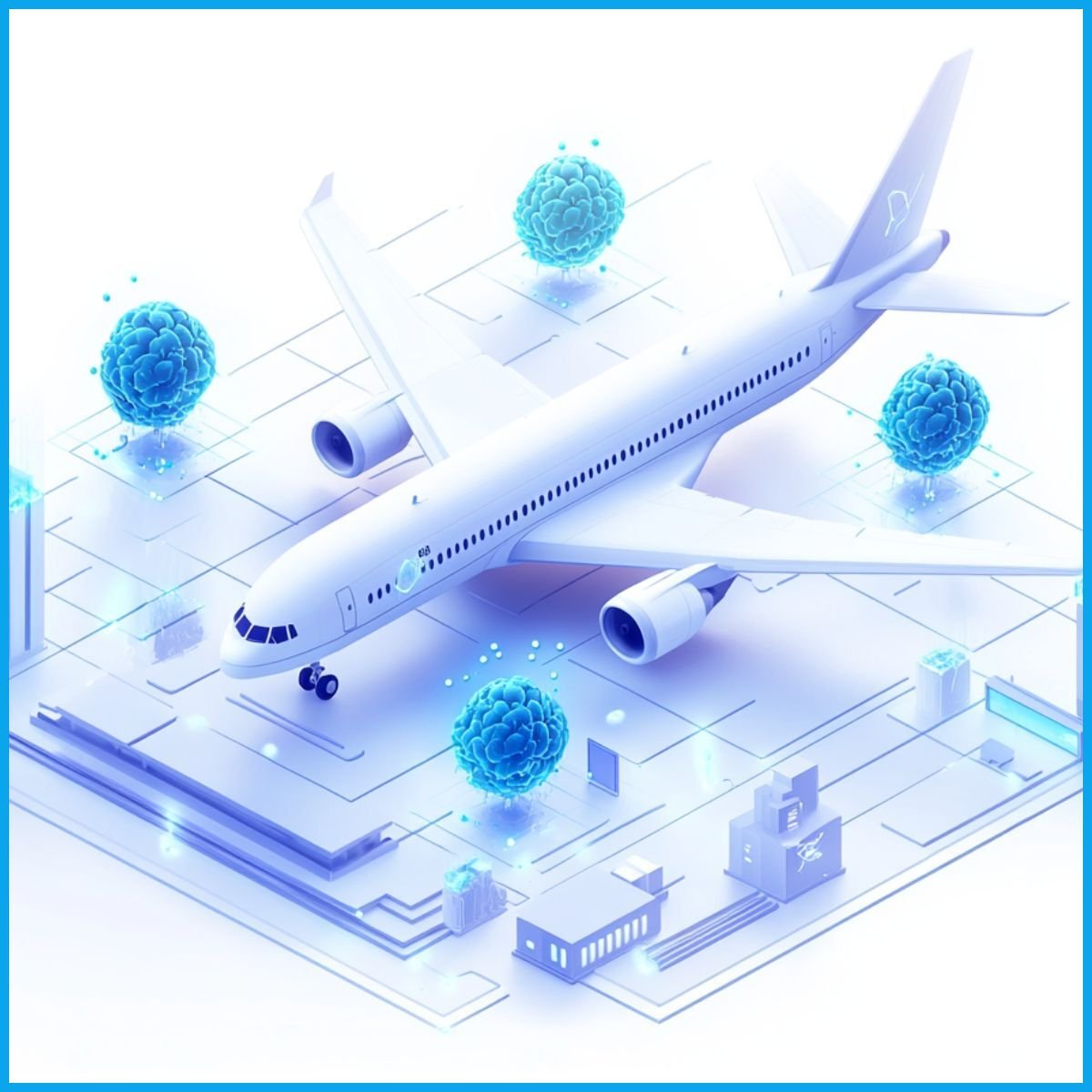
Post-flight paperwork may not make headlines, but it’s a key part of flight operations, and often a major drag on crew productivity.
To streamline this process, Japan Airlines has introduced the JAL-AI Report, an AI-powered mobile app. The app uses Microsoft’s lightweight Phi‑4 small language model to help cabin crew generate post-flight incident reports much faster, even in low-connectivity environments.
- Previously, flight attendants spent up to 60 minutes per flight manually documenting onboard incidents, from medical events to operational anomalies. With the new AI tool, that time has been cut to just 20 minutes, freeing up staff capacity for more meaningful work.
- The system supports voice-to-text dictation, automatic translation (e.g., Japanese to English for international flights), and intelligent structuring of crew notes.
- In future updates, it will even be able to convert in-flight conversations into structured reporting input.
This is more than an administrative upgrade; it’s a concrete example of how AI is removing low-value tasks, improving crew satisfaction, and strengthening operational reporting at scale.
Maintenance records are essential to post-flight operations, but they’re also notoriously fragmented, locked in legacy systems, and difficult to search. For airlines, MRO providers, and aircraft lessors, accessing these records has traditionally required days or even weeks of manual document reviews, slowing critical decision-making and compliance checks.
To solve this, GE Aerospace has launched an AI-powered platform that radically simplifies maintenance record access.
- Built on Microsoft Azure and Azure OpenAI Service, the system uses Generative AI to instantly extract key asset insights from maintenance logs, compliance documentation, and technical data.
- The system was piloted by Carlyle Aviation Partners, a major aircraft lessor managing a global fleet. Early tests showed that the platform not only improved document retrieval speed but also helped identify gaps in compliance records and assess the technical condition of aircraft with unprecedented efficiency.
By enabling stakeholders across the aviation ecosystem, from lessors and maintenance teams to fleet managers and compliance officers, to access consistent, real-time asset information, the platform enhances transparency, reduces administrative overhead, and accelerates strategic decision-making. As air travel volumes rise and fleets age, this kind of AI-assisted coordination will be critical for managing risk, optimizing asset value, and ensuring operational readiness across airline networks.
In aviation, few things are as disruptive and costly as unexpected maintenance delays. Often, they result not from a lack of expertise, but from time lost searching for the right technical documentation. Textron Aviation, producer of over half the world’s general aviation aircraft, tackled this challenge head-on using Generative AI.
- Partnering with Microsoft, Textron built and deployed “TAMI” (Textron Aviation Maintenance Intelligence), a Generative AI assistant powered by Azure OpenAI Service and Microsoft Cloud for Manufacturing.
- The tool gives aircraft maintenance technicians (AMTs) instant access to over 60,000 pages of maintenance documentation, delivering fast, accurate, and concise instructions in response to natural language queries.
Previously, troubleshooting certain issues could take up to 20 minutes. Now it can be done in one to two minutes.
This drastic reduction in search time improves technician productivity, accelerates workforce training, and reduces the overall time aircraft spend under maintenance.
TAMI’s ability to process complex technical content, respond in multiple languages, and fit seamlessly into technicians’ daily workflows makes it a standout example of how AI can strengthen operational reliability where it matters most; on the ground, in the hangar, and at scale.
The Foundation of AI: High-Quality and Trusted Data
As we have learned, AI is already reshaping airline operations. However, as powerful as AI can be, its success is entirely dependent on the quality of the data upon which it is built. Without accurate, complete, and well-structured data, even the most advanced AI models will fail to deliver meaningful results.
This is not just a theoretical concern; it is a well-documented challenge. Gartner predicts that through 2026, organizations will abandon 60% of all AI projects due to inaccurate or messy data.
Other leading analysts confirm similar trends, with some reporting even higher failure rates:
- McKinsey reports that 70% of AI projects fail to meet their goals due to data quality and integration issues.
- Deloitte’s 2024 company survey found that up to 80% of AI and ML projects encounter difficulties related to data governance and reliability.
- And IDC concludes that a staggering 85% of AI projects fail because the data is messy, incomplete, or just plain bad.

These statistics paint a clear picture: flawed or incomplete data leads to inaccurate AI predictions, operational disruptions, and unreliable decision-making. Nowhere is this risk more critical than in aviation, where real-time, mission-critical data underpins the safety, efficiency, and reliability of global flight operations.
The Risk of Poor Data in AI-Powered Airline Operations
The aviation industry is uniquely dependent on real-time, mission-critical data. Every operational decision, whether related to predicting delays, optimizing crew schedules, or managing airspace congestion, relies on a vast network of flight schedules, real-time aircraft movements, weather forecasts, passenger demand patterns, and regulatory requirements. If this data is incomplete, delayed, or inaccurate, AI-driven systems will produce flawed outputs.
In a sector that directly impacts the safety and experience of millions of passengers every single day, there is no margin for error when it comes to data quality. AI can only be as intelligent, reliable, and safe as the data it is trained on.
OAG: The Gold Standard in Trusted Aviation Data
To ensure that AI can deliver on its promise of transforming airline operations, trusted, high-quality data is essential. As the aviation industry’s most relied-upon data partner, OAG provides comprehensive, accurate, and timely datasets that meet the highest standards of compliance and security.
But OAG delivers more than just clean data. It turns raw information into accurate, AI-ready intelligence, enabling airlines, airports, and travel tech providers to confidently develop and scale intelligent systems. From powering predictive models to informing real-time decision-making and long-term strategic planning, OAG’s real-time flight data, historical insights, and analytics form the foundation for resilient, data-driven aviation operations.
Where AI and Trusted Data Converge Where AI and Trusted Data Converge
Despite rapid progress and growing adoption, AI in aviation is still in its early stages. The industry has only begun to tap into the transformative potential of AI and agentic systems in optimizing operations. While current deployments are already delivering measurable benefits, the real transformation is still ahead.
What will define AI’s lasting impact on airline operations?
The ability to combine high-quality data with advanced AI capabilities to extract meaningful intelligence at scale.
AI systems are only as powerful as the data they are trained on. That’s why the future of resilient, disruption-free aviation will hinge on two essential enablers:
Trusted, high-quality data
Clean, accurate, and interoperable data is the foundation for training next-generation AI models. Without it, even the most advanced algorithms fall short. OAG plays a central role in enabling this transformation, delivering aviation data that powers predictive demand forecasting, anomaly detection, disruption management, and operational optimization across the industry.
Advanced AI technology
To unlock the full potential of this data, airlines and airports need powerful, scalable AI infrastructure and technology. Microsoft’s AI solutions provide exactly that, transforming real-time operational data into automated, actionable insights.
With OAG’s trusted aviation platform and Microsoft’s AI capabilities, the industry has a winning formula for a smarter, more resilient future. Airlines will no longer have to react to disruptions; they’ll anticipate and prevent them. Passengers will no longer have to tolerate delays; they’ll enjoy a smoother, more reliable travel experience.
OAG is proud to serve as a key enabler of this AI transformation, providing the technology backbone and data infrastructure that empowers airlines, airports, and travel tech providers to build, train, and scale AI with confidence.
We are ready to lead this change.
If you would like to contact OAG about this report or have a media enquiry please email pressroom@oag.com
Key contributors:

Julie Shainock
Managing Director
Travel, Transport & Logistics at Microsoft

Bhanu Vikrant
Industry Advisor
Travel, Transport & Logistics at Microsoft

Caroline Mather
Chief Marketing Officer at OAG

Filip Filipov
Chief Operating Officer at OAG
MORE FROM OAG
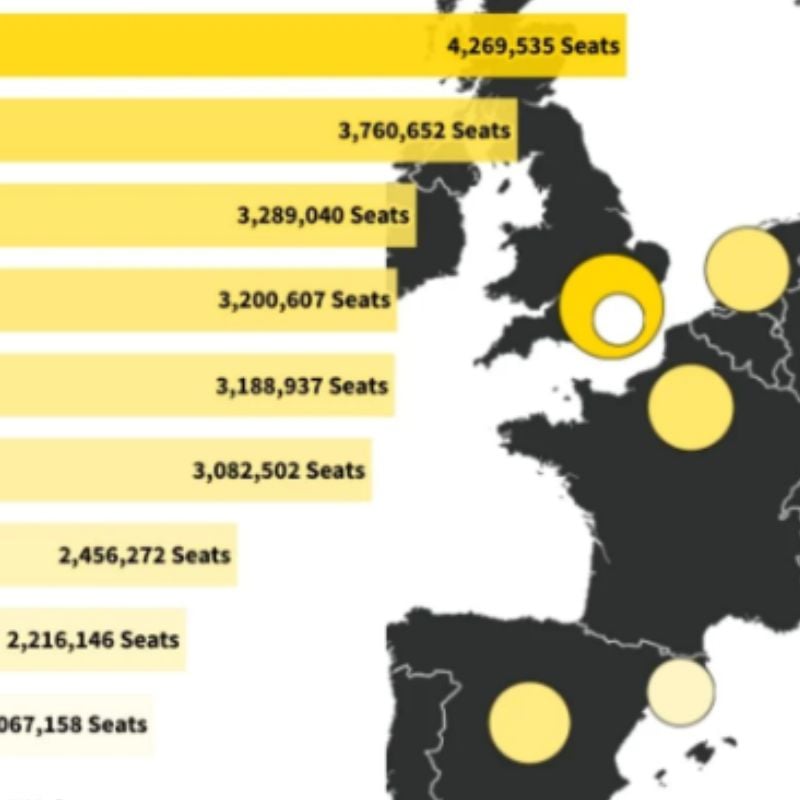
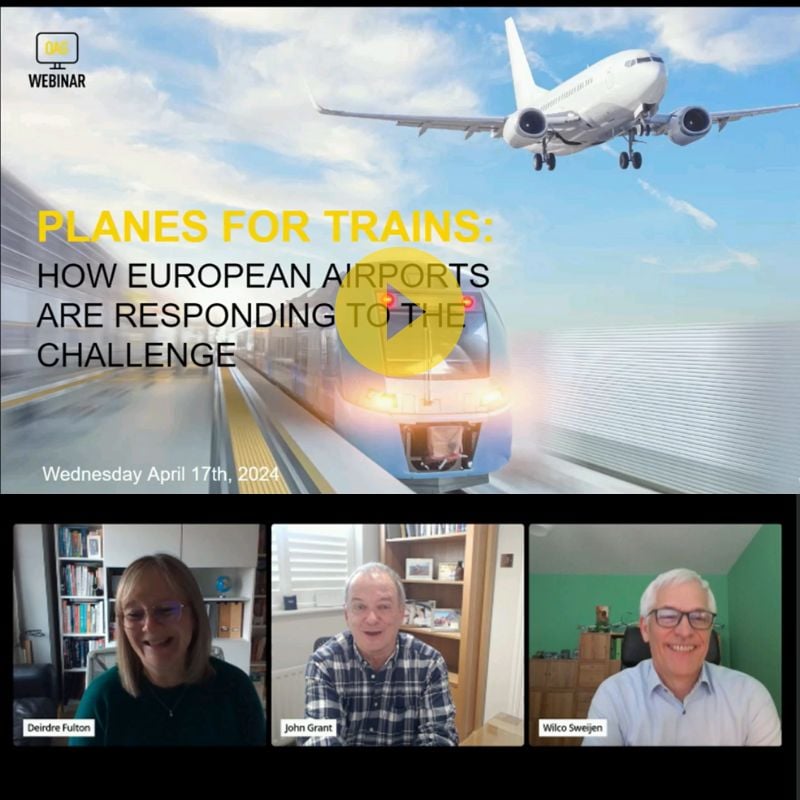
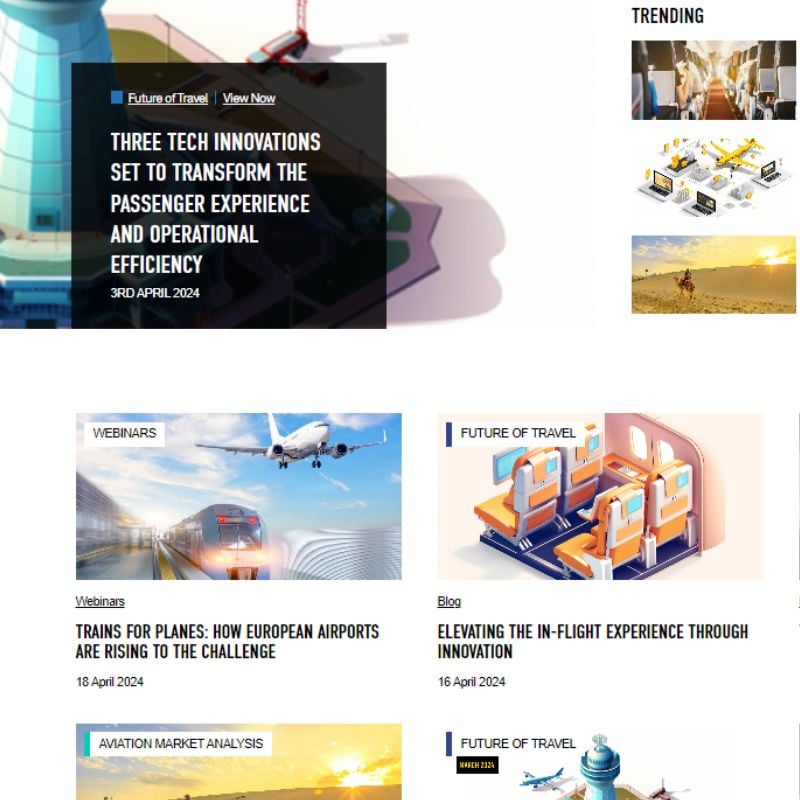
Aviation Market Analysis
Analysis of the latest data and developments in the aviation world.
Read Now
.png?width=1600&height=900&name=Future%20of%20the%20airline%20passenger%20experience%20report%20(1).png)
The Future of the Airline Passenger Experience
How are advances in technology and new data shaping travelers' journeys?
Download Now

